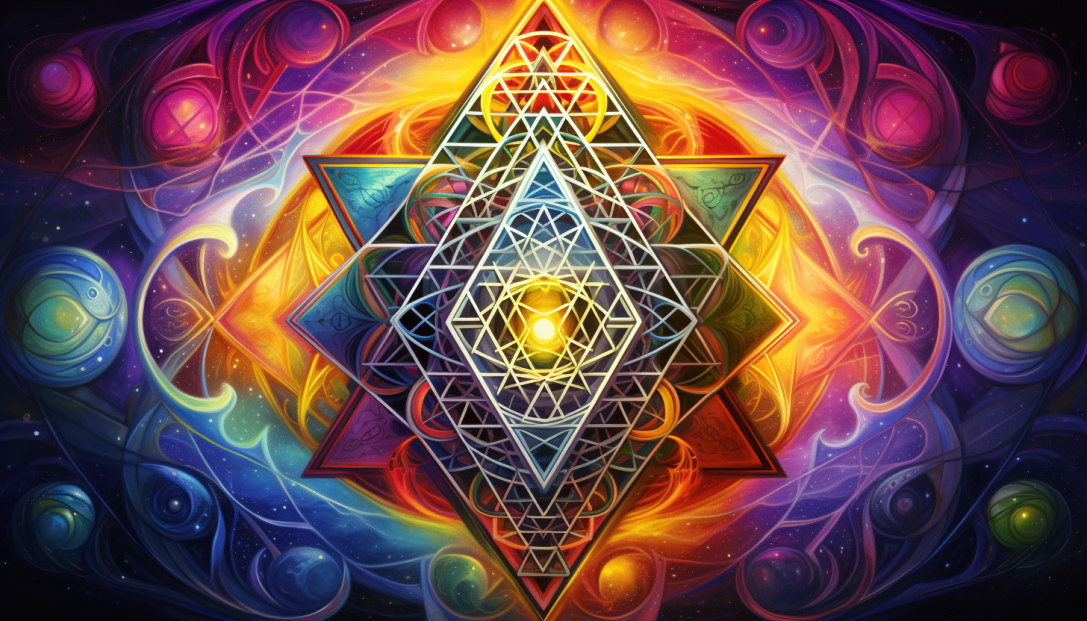Sacred Geometry: Decoding the Universe’s Blueprint
In the grand tapestry of existence, Sacred Geometry stands as the harmonizing framework. This profound realm of thought delves into the consistent patterns, shapes, and proportions inherent in everything – from the tiniest molecule to the expansive universe.
What is Sacred Geometry?
Sacred Geometry seeks to understand the universe and its design principles. It identifies patterns of growth, evolution, and the fundamental forces that shape our world. These sacred patterns serve as visual manifestations of the intimate ties between the part and the whole, the finite and the infinite.
Delving Deep into the Symbols of Sacred Geometry
1. The Flower of Life:
A constellation of numerous evenly-spaced, overlapping circles that create a flower-like pattern. Found in art and religious symbols across various cultures, the Flower of Life is thought to represent interconnectedness, the cycle of creation, and the universe’s infinite nature.
– Origins: Ancient civilizations from Egypt to Greece have depicted this pattern in their temples and art, highlighting its timeless appeal and significance.
– Modern Interpretation: Many perceive the Flower of Life as a visual representation of individual consciousness connecting and aligning with universal consciousness.
2. The Seed of Life:
Comprising seven overlapping circles, it’s a condensed version of the Flower of Life. Each circle can be seen as a day of creation or a chakra point, and it embodies potential and beginning.
– Origins: Traced back to various religious texts, it symbolizes the seven days during which the world was created.
– Modern Interpretation: The Seed of Life serves as a reminder of the boundless potential within us and the universe’s interconnected rhythms.
3. The Vesica Piscis:
Born from the intersection of two circles with the same radius, its almond-shaped middle holds profound meaning.
– Origins: Christian art frequently featured the Vesica Piscis, with Christ or the Virgin Mary often within its shape.
– Modern Interpretation: Symbolizing shared visions, mutual understanding, and the confluence of two distinct forces or ideas, it underscores unity’s strength.
4. The Fibonacci Spiral & Golden Ratio:
This spiral derives from the Fibonacci sequence, a series of numbers where each number is the sum of the two preceding ones. The ratio between these numbers is the famed Golden Ratio, a testament to balance and harmony.
– Origins: Named after Leonardo Fibonacci, an Italian mathematician, though the sequence’s knowledge predates him by centuries in India.
– Modern Interpretation: From art to design, it is a sought-after proportion for its aesthetically pleasing balance. Spiritually, it stands as a reminder of the universe’s inherent order and growth patterns.
5. The Platonic Solids:
These are five three-dimensional shapes that are the same on all sides. Plato linked them to the elements, inferring that these shapes serve as the building blocks of the universe.
– Origins: Dating back to ancient Greece, where the philosopher Plato discussed these solids’ cosmic significance.
– Modern Interpretation: As representations of the earth’s elements, they highlight the material world’s interconnectedness and the delicate balance maintaining our existence.
Sacred Geometry Today: Beyond Shapes and Patterns
While rooted in ancient wisdom, Sacred Geometry’s essence remains vibrantly alive in contemporary life. From architecture’s breathtaking designs to meditation practices that harness these shapes for spiritual alignment, the symbols and teachings of Sacred Geometry continue to guide and inspire.
For ‘Insightful Universe,’ Sacred Geometry isn’t a relic from the past; it’s a beacon for the future, illuminating the path to understanding the cosmos and our place within it. When we gaze upon these symbols or see them manifested in nature, we’re reminded of the intricate tapestry of existence and the universal harmonies that bind us all.

